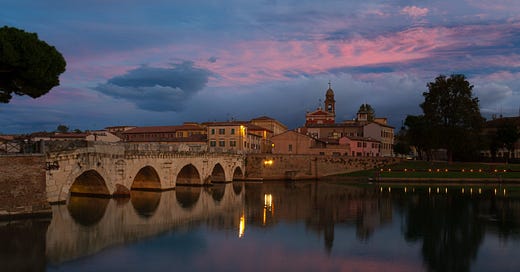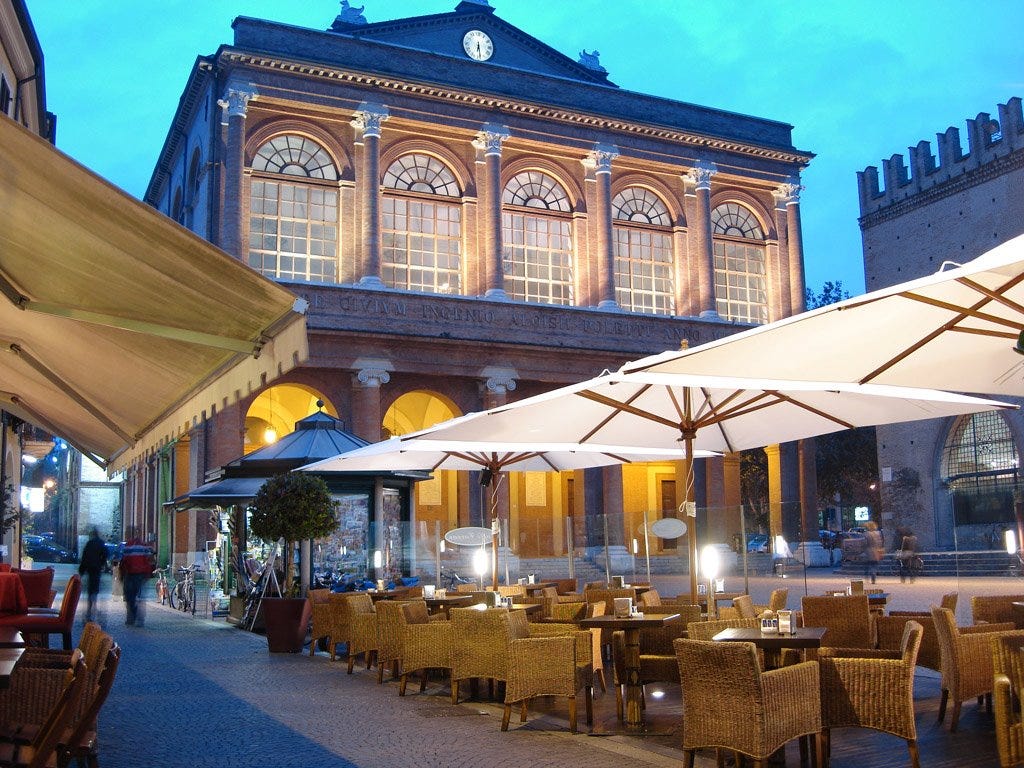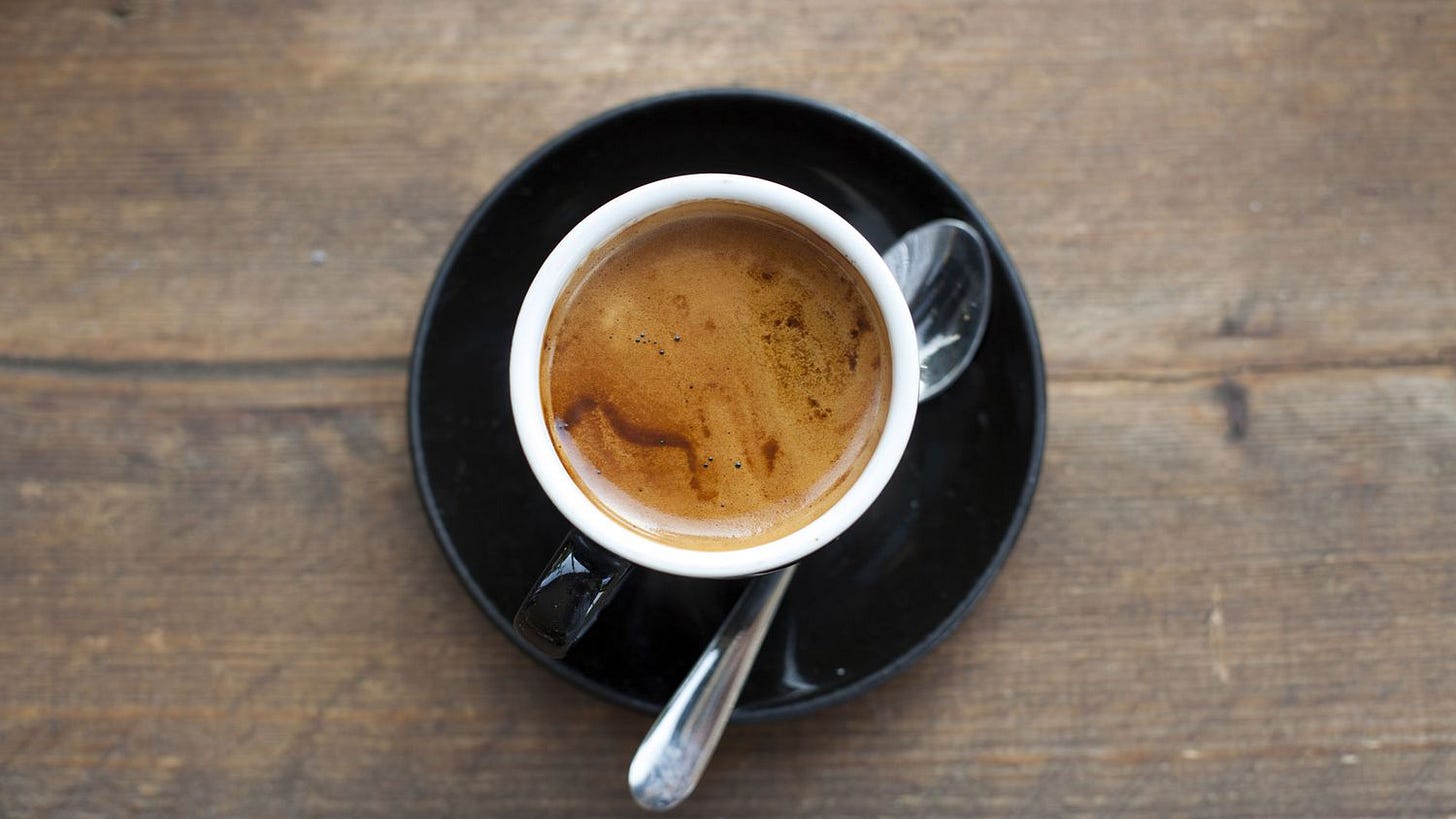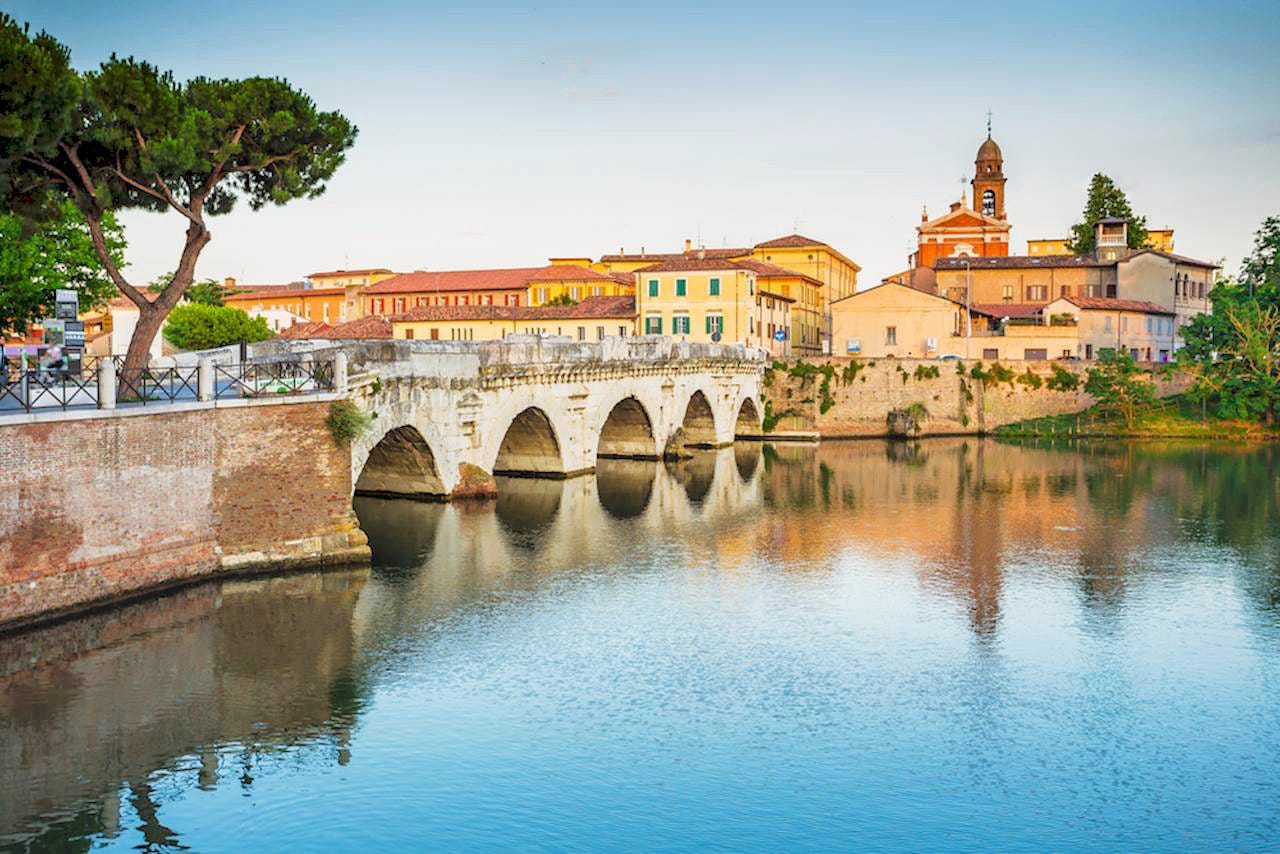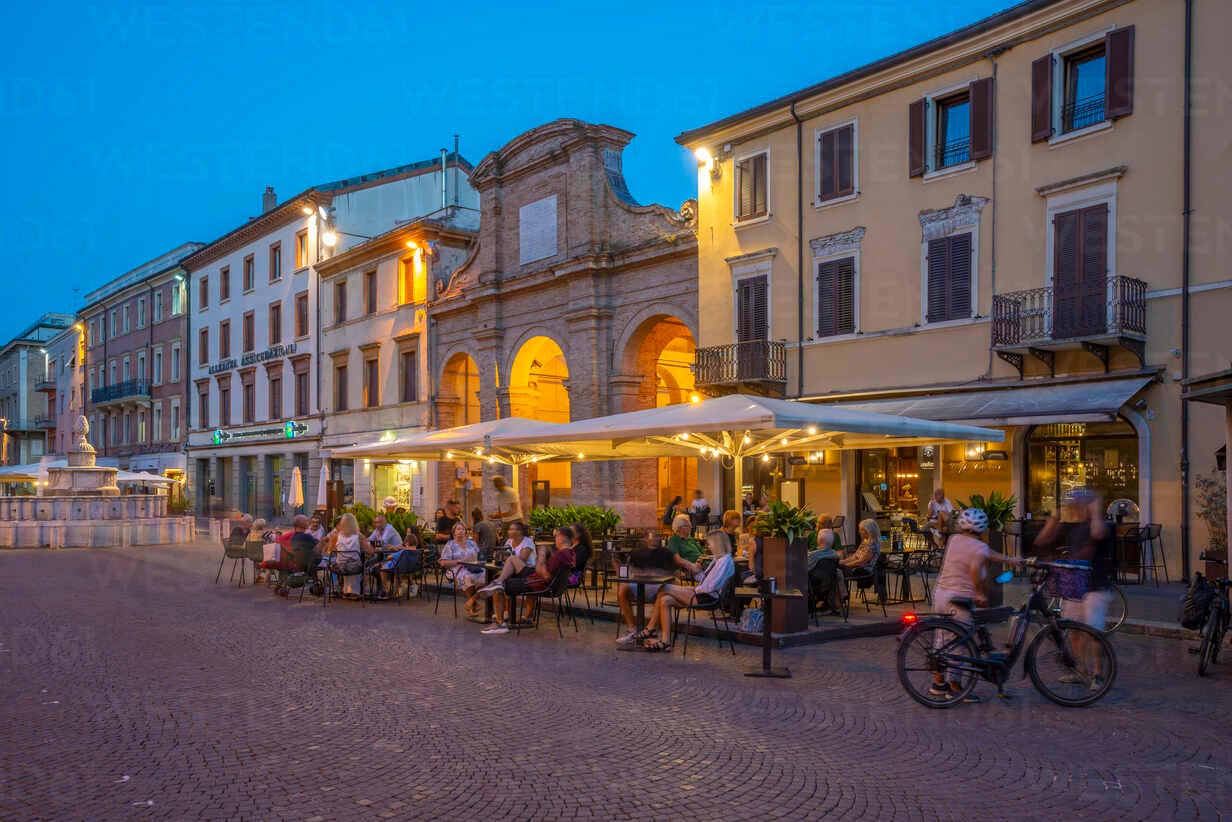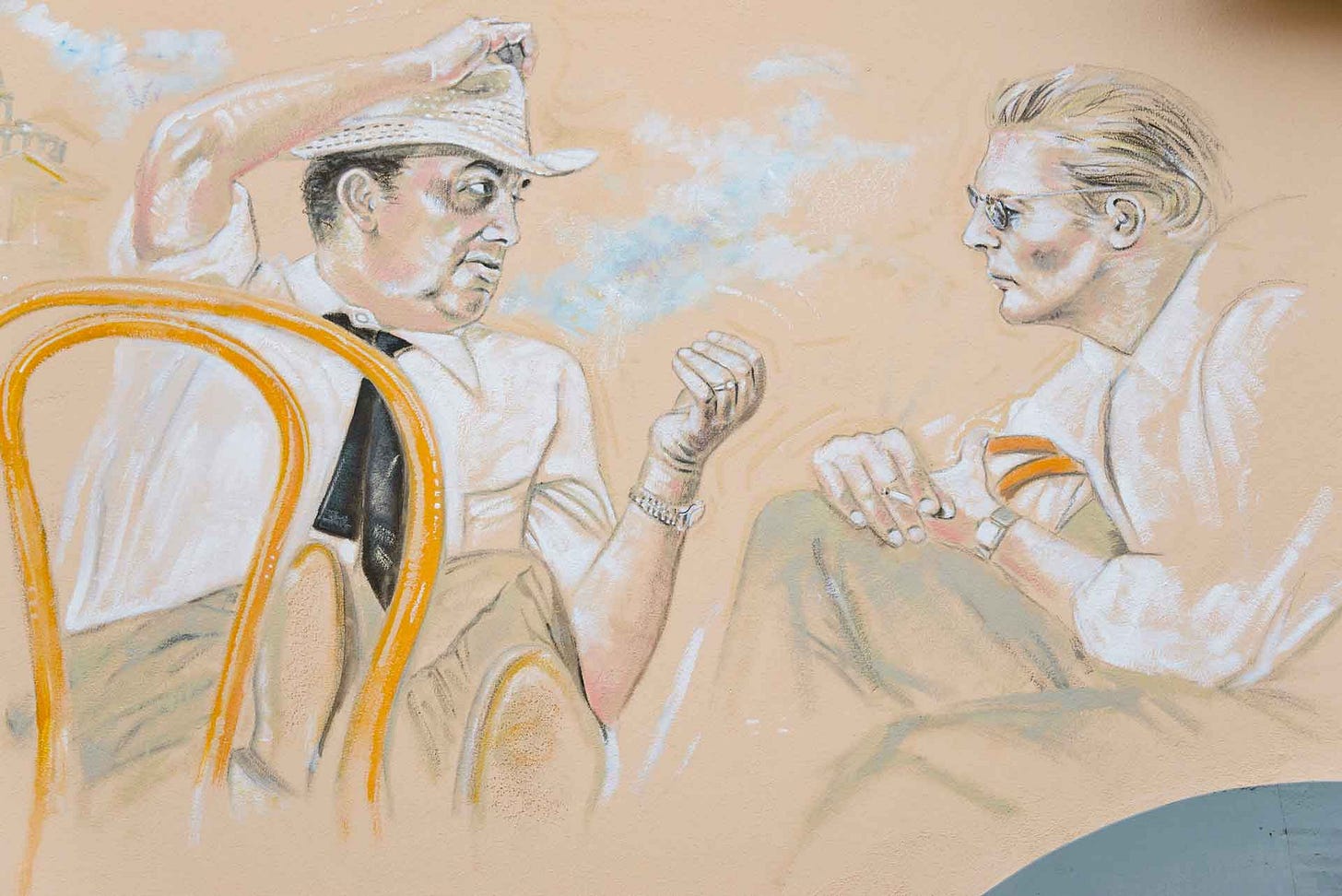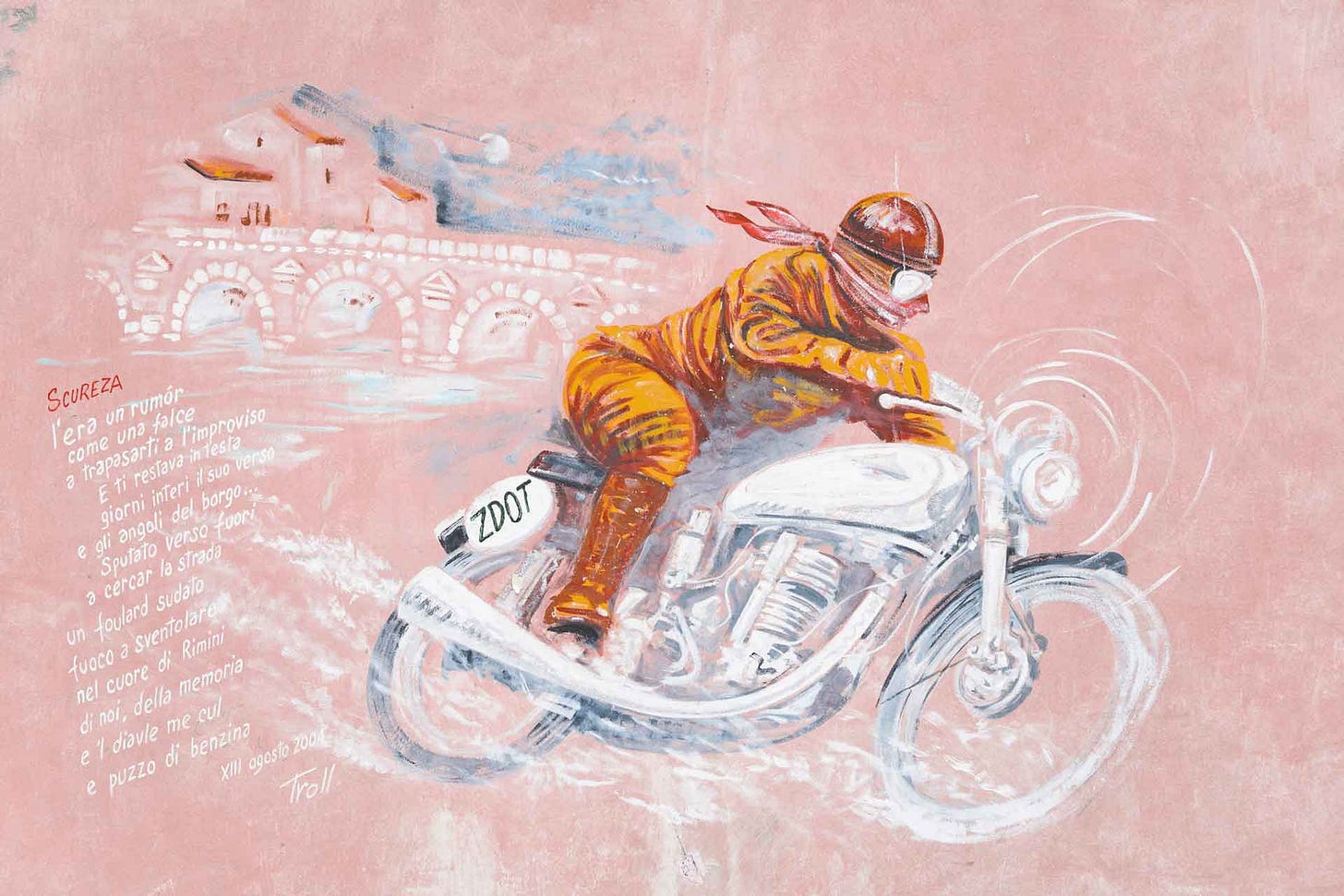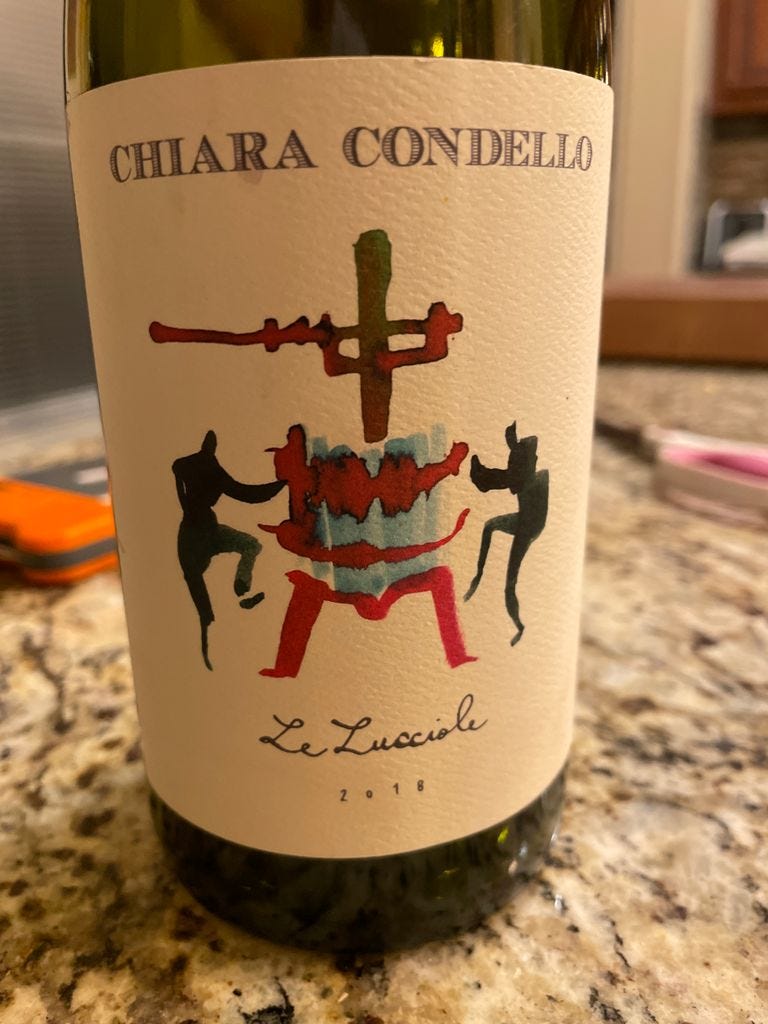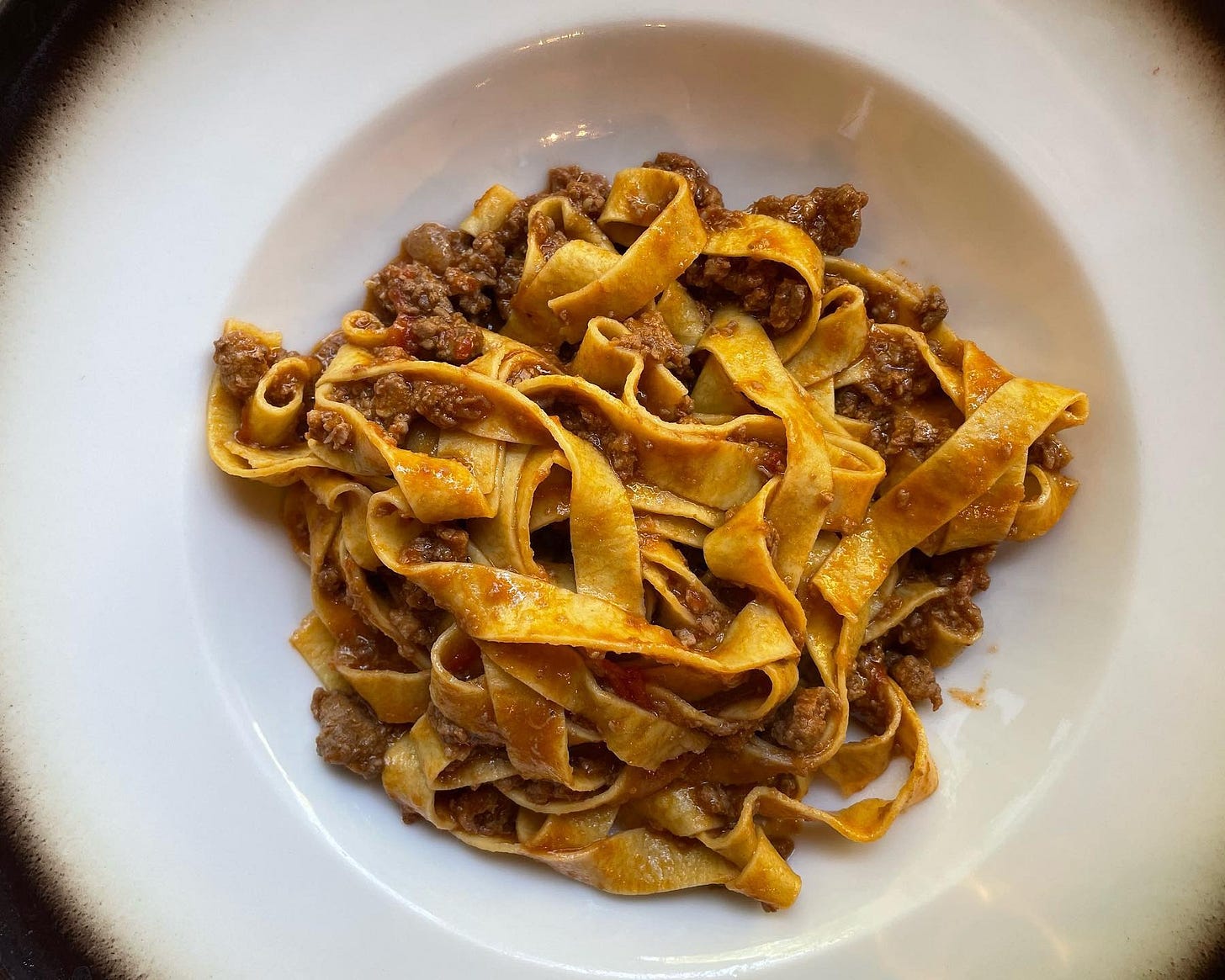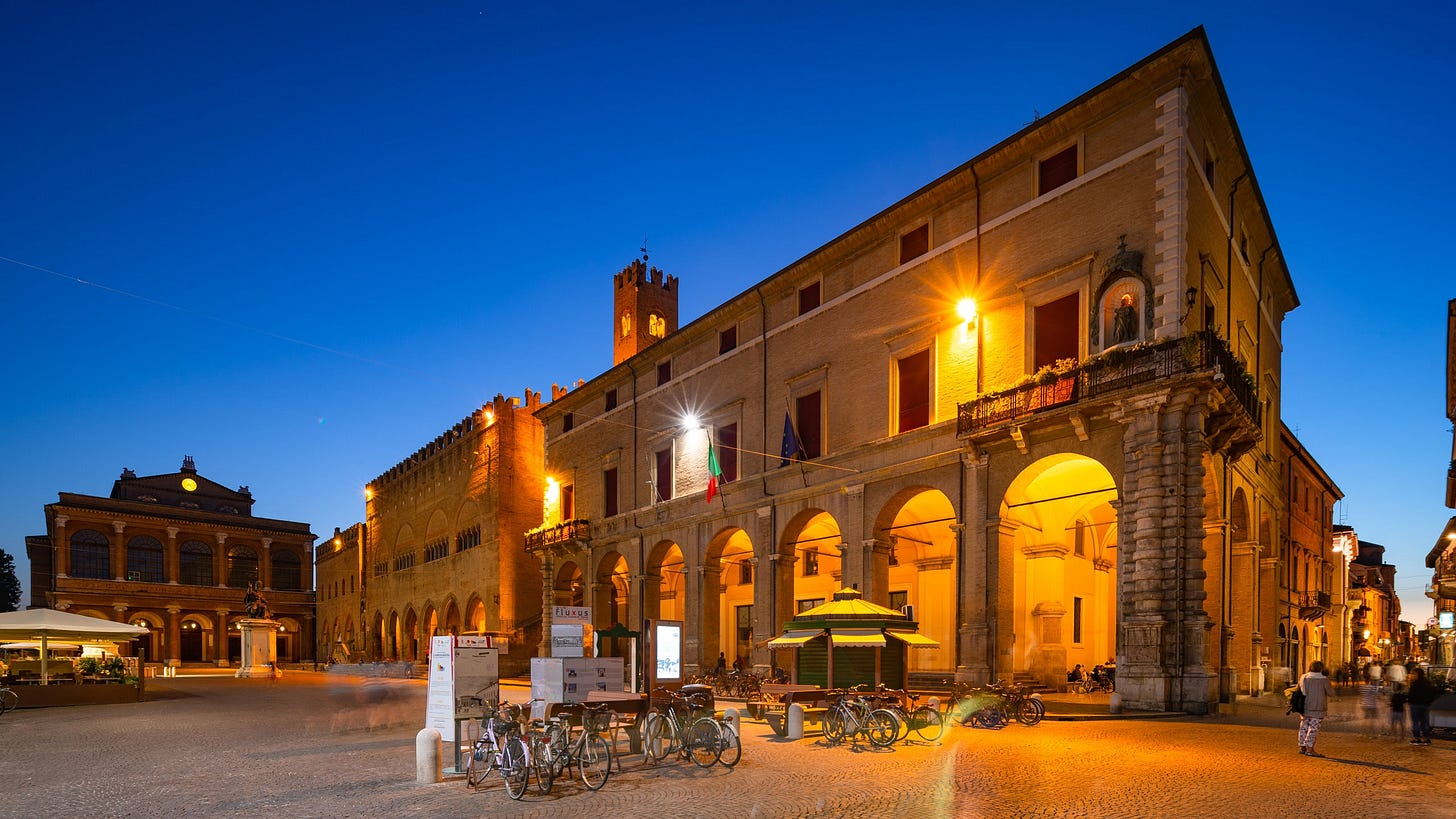The Secret of Rimini. The Magic of Federico Fellini. The Perfect Slice of La Dolce Vita.
Rimini didn’t reveal itself to me all at once. It teased me. It gave me hints. It left me wanting more with every glance.
Rimini. The birthplace of revered film director Federico Fellini. The visionary behind La Dolce Vita and 8½, regarded by fans and critics as one of the world’s greatest film-makers. It was a coastal town with history spanning from the Roman to the Renaissance and a place known by most locals for its relaxing beaches and its active nightlife. I stepped off the train from Bologna and onto the concrete platform as I arrived in this local getaway. Through the crowds of locals and the mingled smells of gas and train station espresso, the smell of salt air that drifted from the sea hit me like a slap in the face. Rimini might have been a small town, but it was extremely special. It was a city that seduced you slowly. Taking its time as it lured you in with its beaches, then with its food, and then with its lingering aroma of espresso and pasta wafting through its narrow and ancient cobblestone streets. As I exited the platform, my stroll felt like I was peeling back layers of Italy’s soul one step at a time. Rimini greeted me warmly on this typical Italian summer day, with its Adriatic breeze and with an air of nostalgia. It was the kind of feeling that clung to places like these where history and modernity collided on every corner.
The afternoon streets were bustling with tourists and locals alike who navigated the narrow alleys with the practiced ease of repeated familiarity. I shouldered my bag and set off down one of the old narrow streets. With no set itinerary or plan, I followed my nose and let my feet carry me forward. In Rimini, every corner held a story. Every building was a piece of history. All you had to do was look, and the centuries, and even the millennia would stare back at you at every glance. As was my general routine when traveling in any city, a stop for coffee was not so much as want as it was a need. I popped into Caffè Cavour as I strolled by without a moment’s hesitation. The wafting aroma of espresso lured me in and I could smell that they were brewing good shit inside. The cafe outside was packed with people all enjoying a lazy afternoon siesta. And, as there was a line to sit, I did what any good local Italian would do—I bypassed the line and idled straight up to the bar. As I panned around the busy room, locals chatted animatedly, their gestures punctuating every syllable. Locals went about their day with the unhurried pace of those who know the sun would always rise again tomorrow. Tourists lingered over their phones, their faces lit with discovery and interest as they were more engaged online than they were in person. This was Rimini: a city that invited you to pause, to savor, and to watch life just happen around you.
"La dolce far niente" was present all around me. It was an Italian phrase that translated to "the sweetness of doing nothing" or "sweet idleness.” It emphasized the pleasure of relaxation and just taking the time to enjoy the simple moments of life. It was an art form the Italians perfected, and one I was more than happy to study and fully emulate. I leaned against the bar and slowly drank my espresso as I flipped through the local newspaper. I took my time and watched the ebb and flow of life as it passed through the cafe. With my first espresso gone, a distant memory of floral chocolate as I was lost in the moment, the bartender behind the mahogany counter brought me another, and I willingly accepted. Far be it from me to turn down more coffee. Here in Italy, it was considered an act of blasphemy.
I thanked and paid the barista for my espressos as I polished off the last drops from my tiny cup. I slung my bag across my shoulder and headed out into the sunshine of the origin of La Dolce Vita. There were nine long miles of beaches that stretched along Rimini's coast to enjoy. They were a golden ribbon separating the Adriatic from this ancient town. Most of the beaches were sadly claimed by the hotels that lined the shore, their neat rows of umbrellas and loungers were a colorful patchwork against the sand. But there were still pockets of public beach, where locals and savvy tourists alike could spread their towels and soak up the Mediterranean sun without being bothered.
Even with its beautiful, calm beaches, Rimini was more than just a beach town savored by day-tripping locals and tourists. This old city's long and storied history was on display for all to discover and experience. The Arch of Augustus that stood proudly since 27 BC was an excellent reminder that Rome had a very long reach. The Tiberius Bridge that spanned the Marecchia river since the early 1st century, still carried traffic after two millennia and only added to the mystic and genius of Roman construction and ingenuity. These tourist attractions were living history that were still in use and enjoyed today. They were as much a part of Rimini's daily life as the cafes and gelaterias that were scattered across the small town.
Feeling the full effect of two espressos buzzing through my head, I wandered into Piazza Cavour, one of the oldest squares in Rimini. It was medieval center of government and business, ringed by buildings that have stood by and watched time slowly move in front of them. The Piazzo dell'Arengo was built in the early 13th century to house the city council and courts. Its ground-level portico of pointed arches were a stark contrast to the bold crenelations crowning its top edge. Next to it, stood the Palazzo Podesta from the nearly same era. Both were stunning and equally imposing and majestic in their own right.
The sun slowly began to wane in its movement towards the late afternoon and into the evening. It cast long shadows across the piazza as I made my way to Borgo San Giuliano. This former fisherman's village had been transformed into a living tribute to Rimini's most famous son, Federico Fellini. It’s safe to say that Borgo San Giuliano stole my heart completely. The walls were adorned with murals inspired by many of Fellini’s films. I wandered through the streets, my mouth slightly open, as I stared at one scene, and then another, unable to move myself away from murals which brought my childhood back into focus in stunning three dimensional vibrancy. There were scenes from "La Dolce Vita" and "8½" that were vibrant and colorful against the walls of the old buildings. Walking the narrow streets here felt like stepping into one of Fellini’s films—completely surreal yet grounded in breathtaking emotion. Every painted wall I lingered at told a story. Every corner whispered Fellini’s dreams and even reminded me of several of my own.
The narrow streets were like a path of discovery. Each turn revealed new artistic treasures, and in Piazzetta Gabena, I stopped and marveled at a mural of Fellini himself. He was depicted larger than life and seemed to watch over the neighborhood, protecting his childhood and his legacy. It was easy to see how this city could have inspired his fantastical films. His babies. His creations. His legacy. The lines between reality and fantasy blurred here more than any other place in Italy. Walking along these streets, it was easy to see the everyday and the extraordinary existing side by side no matter where I turned. And as I wandered back towards Piazza Cavour, I suddenly noticed the gentle bubbling of the Fontana della Pigna. I stopped to take in the piazza, letting the scene linger on my eyes for a moment. In the background, the fountain bubbled quietly; its waters at one point had quenched the thirst of an entire city. Today, however, the fountain stood resolute and quenched curiosity instead.
As the heat of the Italian summer slowly dissipated, the energy of the city diminished and slowed down to welcome the evening. The beach-goers retreated back to their homes and hotels, as did most of the tourists that were drawn to the water’s edge to bathe themselves in the midday sun. The night owls and the restaurant patrons all appeared and slowly replaced the day-trippers and tourists. Rimini's reputation for nightlife was well-earned. It’s bars and clubs catering to every taste and budget. And while I could have absolutely indulged on an Aperol Spritz, sitting outside at one of the many bars, my empty stomach reminded me that I hadn't eaten since my morning's cornetto. It was early enough in the evening that I knew I didn’t need a reservation. Like Spain, many Italians will dine later in the evening. While I did stand the chance of identifying myself as a foreigner for eating dinner so early, I figured it was worth the risk to keep myself from starving completely. I chose a small place off the beaten path that promised authentic, local cuisine, and made my way over to Osteria Io e Simone. The chalkboard menu was a like a love letter to the region's gastronomic indulgence. Each dish told a story of the land and sea that surround Rimini, deeply wound with the traditions of the local Nonne who were the guardians and carried the weight of the region’s cultural recipes in their collective kitchens.
I relaxed in my seat as my eyes scanned the menu. My server stepped away for a moment, giving me some time to read over everything. If you have never ordered in Italy before I can offer you one bit of advice. Don't be in a rush. Enjoy the moment. Savor the menu. And really, just slow the fuck down. You’re in Italy. Take your fucking time. My server returned with a smile as she gestured towards me, awaiting my decision. I chose the more local option for dinner this evening and ordered the Cappellacci ripieni di zucca, al ragù. For all of you non-italian speakers, it translates to pasta stuffed with pumpkin, served with ragù. My server motioned to the wine list, but I already knew exactly what I wanted. She smiled instantly as I ordered a bottle of 2018 Le Lucciole Romagna Sangiovese Predappio Riserva DOC to accompany my meal. And yes, I knew it was going to be delicious.
I knew this wine very well. It was more than just an accompaniment to the meal, it was practically a meal on to itself. The winemaker was Chiara Condello. Her family had been in the winemaking business for generations. Her vineyard, a small plot of land at an altitude of 150 to 300 meters, was once under the sea. Every sip. Every taste. Every nuance of flavor whispered stories that were three million years of history in the making. Chiara was an expert in her field and a growing force as a female winemaker in the industry. This wine, in particular, underwent a spontaneous fermentation in open wood barrels and steel, with 25-45 days of maceration before being aged in Slovenian oak for two years. The result was fucking sublime—a terroir transformed into liquid art.. It was a structured wine that coupled red fruit like cherry and plum with earthy notes and tones. It was a perfect match for the rich, luxurious and deeply comforting flavors of the pasta where every bite felt like a warm and delicious blanket wrapped around my tongue.
I finished my meal, and passed on dessert. When my server showed me the menu, she laughed as I pointed to the bottle where I identified the remaining wine as my dessert. She nodded and gave me a few moments to enjoy the rest of Chiara Condello’s fabulous bottle. I had finished dinner rather early, considering Italian-time. And as I took the final sips from what was left in my glass, I noticed couples and families beginning to gather, checking in on their reservations, sitting down together for a meal as they welcomed in the evening. I paid my bill and thanked my server profusely. I inserted the cork into the bottle gently and gave her the Sangiovese with a remaining glass of wine sloshing inside. “For you… Per te,” I said. “Il pasto è stato fantastico,” I finished. She beamed at me as she accepted the bottle. “Grazie signore!” She said as she kissed me on both cheeks. I smiled and wandered off into the evening, as I was unsurprisingly drawn back to the beach. The sun was just setting as it painted the sky in shades of orange and pink that would have probably caught Fellini's eye in an instant. Couples strolled barefoot, hand in hand along the water's edge, slowly sacheting through the gentle sea, in no hurry to go anywhere at all. Families played in the gentle waves. Children splashed along the water’s edge as their laughter carried on the sea breeze all around me.
I stood on the edge of the water, hands in the pockets of my linen pants as the fabric flopped on the breeze, my feet planted in the sinking sand. I watching as day gave way to night, graciously, without a struggle. The first stars appeared slowly, twinkling above the darkening sea as the light gently receded behind me towards the west. Federico Fellini once said, "Rimini is a dimension of memory." Until I experienced this magnificent town, I never truly understood what exactly he meant. This town, with its ancient stones and modern beats. With its fisherman's tales and cinematic dreams. This city existed in a space between reality and imagination. An imagination that only Fellini in his creative madness could have brought to the screen. Everywhere I turned, I saw Fellini’s inspiration bathed across the town. From its ancient streets and alleys, to its pasta dishes made with care and love. Rimini didn’t reveal itself to me all at once. Rather, it teased me. It gave me hints. It left me wanting more with every glance. This, was the secret of Rimini, the magic of Federico Fellini, and the perfect slice of La Dolce Vita.

